DH.9a ‘Ninak’ (Post War)
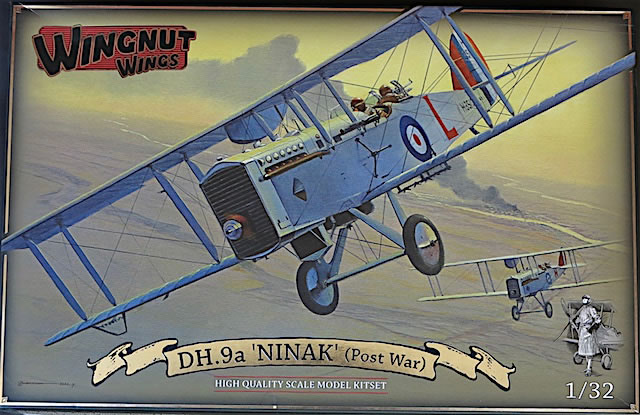
Wingnut Wings, 1/32 scale
| S u m m a r y |
Catalogue Number: |
Wingnut Wings Kit No. 32061 - DH.9a ‘Ninak’ (Post War) |
Scale: |
1/32 |
Contents and Media: |
344 grey coloured plastic parts (20 unused); 4 clear plastic parts (1 unused); 1 decal sheet containing markings for 5 different aircraft; 22 page A4 instruction book with full colour painting and marking guide. |
Price: |
USD$139.00 with free worldwide shipping available online from Wingnut Wing’s website. |
Review Type: |
First Look |
Advantages: |
Interesting subject; well-moulded and engineered plastic parts; comprehensive instruction booklet; good range of marking options; high quality Cartograf decals. |
Disadvantages: |
None. |
Conclusion: |
This is a superb kit of an important post-World War I RAF and Soviet aircraft. If you’ve already built a Wingnut Wings kit, you’ll know what to expect; if you haven’t, the Ninak would be a good one to start with (in either this boxing or its original release with wartime markings). Don’t be put off by the complexity of either the kit or the subject; take your time and the quality of the product will result in a great looking and impressively sized model. Highly Recommended. |
Reviewed by Brad Fallen

HyperScale is proudly supported by Squadron
The Aircraft Manufacturing Company de Havilland 9a ‘Ninak’ was a development of the AMC DH.9, a promising design dogged by its underperforming 230 hp Siddeley-Deasy Puma engine. Redesigned to accommodate the 400hp Packard Liberty V12 engine, the new aircraft proved to be one of the Allies’ best light bombers of World War I.
The DH.9a was used to good effect by the RAF and US Marine Corps in late 1918, before going on to clock more than a decade of British and Commonwealth service around the world. Many post-war Ninaks featured refinements such as revised flight instruments, auxiliary radiators and upper wing leading edge slats. Other changes were forced by harsh operating environments such as Iraq, and included auxiliary fuel tanks, new stowage compartments, stronger undercarriage, the removal of wheel covers and spare wheels lashed beneath the fuselage. These modifications varied from aircraft to aircraft, which makes references essential if you are modelling one of these machines.
British factories built nearly 2,000 DH.9as, with a further 2,400 produced without licence in the Soviet Union as Polikarpov R-1s.
Wingnut Wings released its first DH.9a kit back in December 2010, along with the RE.8, Pfalz D.IIIa, Hansa-Brandenburg W.29 and Gotha G.IV. At the time it was Wingnuts’ second largest kit after the Gotha, with a wingspan of 43cm; I haven’t seen a built example but it’s clear from numerous online logs that it’s an imposing model when finished. Reviews were overwhelmingly positive: Andy Ieronymides’ full-build report for Model Airplane International in January 2012 was typical in concluding that
I can honestly say that I cannot think of one negative thing to say about this kit. Beautifully engineered, easy to build, thoughtfully designed and great value for money....
This initial release featured markings for five wartime Ninaks, all camouflaged in variations of PC 10 and Battleship Grey over Clear Doped Linen. I bought one three years ago with the intention of cobbling together markings for a silver-doped Royal Australian Air Force machine from the 1920s. I should have waited, because in November 2015 Wingnut Wings released a post-war boxing of the kit that contains exactly these markings, along with a new sprue of parts to address the unique characteristics of these later variants.
Steve Anderson’s box art shows two silver-doped DH.9as of 8 Squadron RAF (one of them kit marking option B) in flight over Baghdad and the Tigris River. As usual with Wingnut Wings kits the box is filled to the brim with plastic, decals, photo-etch and instructions. My thoughts on this are as follows, starting with the new plastic parts created for this boxing.
New plastic parts
Wingnut’s original Ninak kit contained 292 grey plastic parts on 10 sprues; these are all present here along with 42 additional parts on a new sprue J. The inclusion of the original parts means of course that your options aren’t limited to post-war aircraft – with appropriate decals and the earlier instructions downloaded from the Wingnut Wings website, you can build a wartime DH.9a if you want to.
The new parts include:
- Undercarriage. There are revised undercarriage struts and a split axle for use on marking options A-D, with marking option E – the Polikarpov R-1 – using equivalent parts from the original kit. The new axle and struts feature finely moulded rivets and other raised detail, and convey the robustness of their full-sized counterparts – this may be the first Wingnuts model I build that doesn’t sway alarmingly when moved.
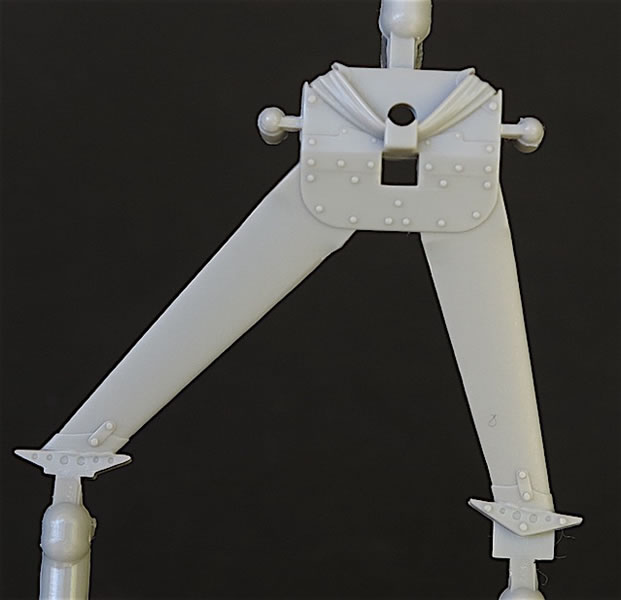
-
Wheels.
-
All five of the marking options have covered wheels, and you will use the original kit parts for these (both weighted and unweighted wheels are supplied). Options C (39 Squadron) and D (RAAF) also use the original wheel covers with a circular valve access hole, but options A, B and E use new covers from sprue J that have five dimpled attachment points and no access hole. (If you are building the R-1 you will need to sand off the attachment points, which will take only a few moments.)
- Sprue J also contains three new wheels, which unlike the originals are moulded as rims and tyres only. Why? Only one of the new wheels is used (for options A and B where it is lashed beneath the aircraft as a spare); the other two are nominally not required. Wingnuts has included them, I think, should you wish to model a machine without wheel covers – ie with spokes exposed. Spoked wheels would be tricky to scratch-build, but Wingnuts may be intending to release etched spokes at some time in the future (they have already produced these for their recent Albatros B.II kit). In the meantime, Rowan Broadbent from Pheon Decals has told me he will soon be releasing a spoked wheel set for this kit, which will undoubtedly please many modelers, myself included.
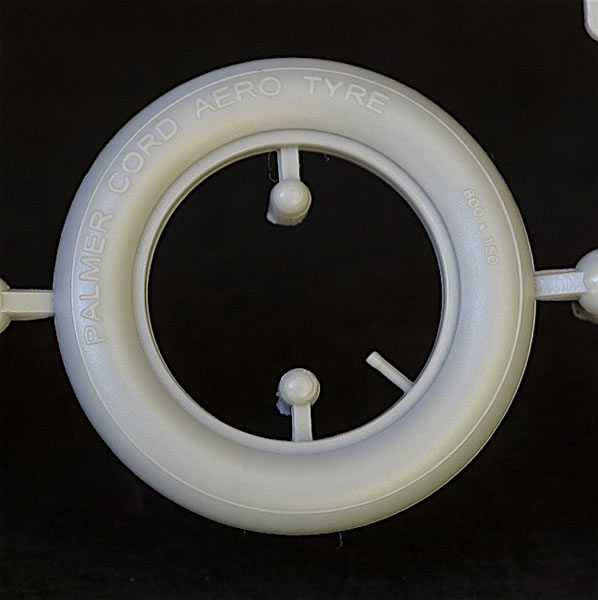
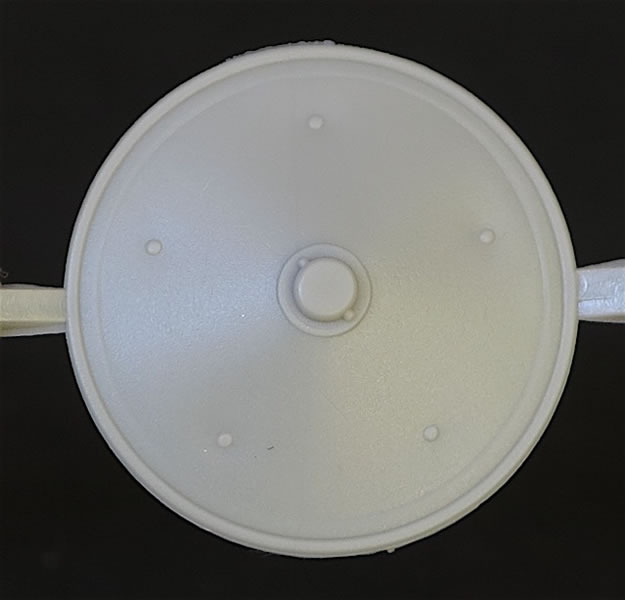
- Top wing leading edge slats. These slats are an interesting inclusion because they are only applicable to one of the marking choices – the RAAF aircraft – and then probably not for the period covered by the markings provided. However they are a useful inclusion because they give modellers a wider range of potential subjects. The slats themselves are finely moulded although they have some prominent ejector stubs on their lower surfaces that will need to be carefully removed. You will also need to perform some minor surgery to the upper wings in order to attach the slats.
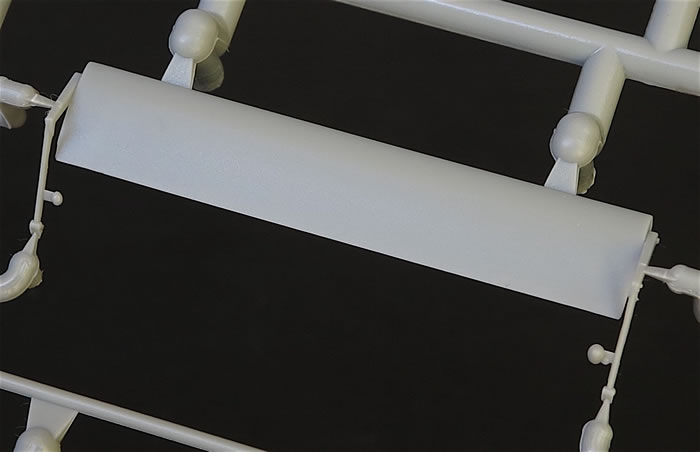
- Auxiliary fuel tank. This is only required for options A and B – the 8 Squadron machines from Iraq – and should be straightforward to attach beneath the upper starboard wing. The tank is a one-part moulding which is preferable to the multi-part tanks Wingnuts provided with their Fe.2b kits, which required some careful cleaning up to remove seams without damaging nearby detail.
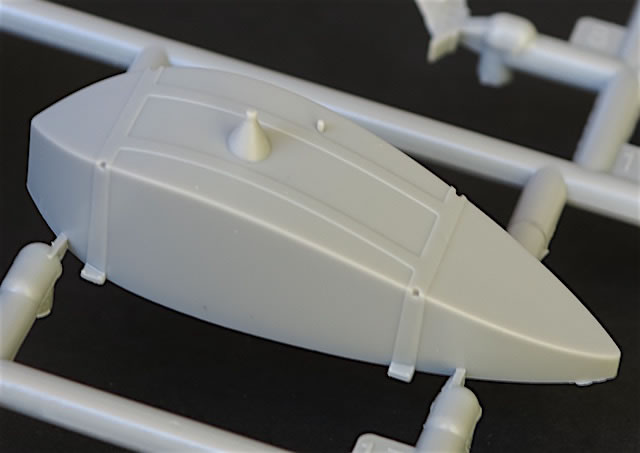
- Auxiliary radiator. Again only required for the Iraq machines, this is a neat five-part assembly that along with the spare wheel will give a decidedly ‘bitsy’ appearance to your finished model.
- Instrument panel. The new panel has a different configuration of instruments to the panel from the original kit, and matches closely with a photo I have of an RAAF Ninak panel. Different styles of compass are provided for the RAF/RAAF and Soviet aircraft.
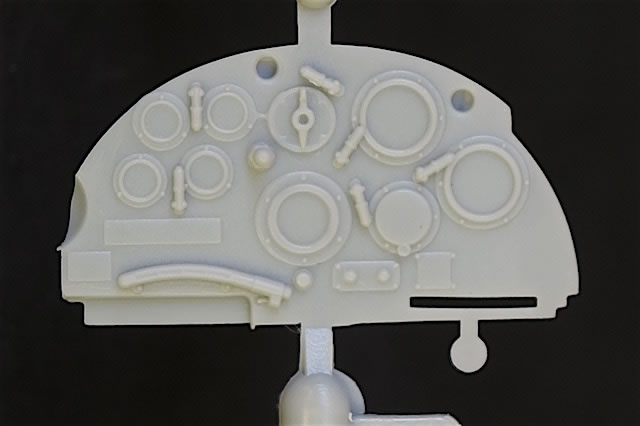
The Wingnut Wings website also describes the kit as having “88 updated armament parts”. In both the original and post-war boxings these parts are provided on two identical ‘R’ sprues labeled “RFC Armaments”, and a quick comparison reveals the sprues are indeed different between the kits. The main (but not only) differences are:
- The addition of a 230lb bomb to complement the smaller 100lb HERL bombs and 20 lb Cooper bombs; and
- A reduction in the number of guns supplied from six to just one Lewis Mk.II and one Lewis Mk.III, reflecting the fact the two of the five post-war options were unarmed.
New photo-etched parts
The new plastic parts are complemented by a revised fret of photo-etched parts, which is significantly larger than its equivalent in the original kit.
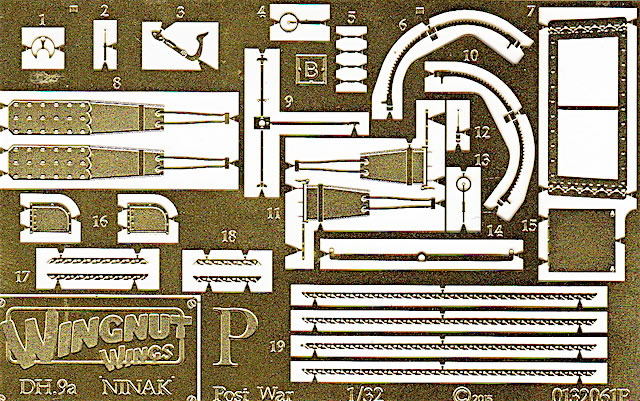
The highlights here are:
- Additional fuselage stitching for options B and C, which will need to be carefully attached after sanding off the existing moulded detail.
- New footsteps for options A-D that should be attached to the port mid-fuselage after the moulded steps on the starboard fuselage have been sanded off.
- The framing for a storage locker situated immediately behind the rear cockpit on options A and B, and possibly also C and D, which will require minor but precise surgery to remove some unwanted plastic from each fuselage half.
The seat harnesses have also been slightly revised and now have longer attachment points, which should make them easier to pose.
Original plastic parts
I won’t go into detail about the plastic parts that have been carried over from the original 2010 release, other than to say they’re up to Wingnut’s usual excellent standard. Production quality is superb, with moulded detail – on both larger airframe components and smaller internal – close to the limit of what can be achieved in plastic. The engine cowlings are a good example of this, with very finely moulded vents and hinges.
Every build review of this kit that I’ve read highlights quality of fit and ease of build. This is consistent with the two Wingnuts kits I’ve build and the one I’m finishing now, where the few problems I’ve encountered have been of my own making. Certainly I would expect no difficulty with attachment and alignment of the struts and top wing, one of the great pre-Wingnuts challenges of biplane model construction.
Rigging will also be straightforward – if time-consuming – thanks to the pre-hollowed location points and helpful rigging illustrations. My preferred rigging material is EZ Line, anchored with eyelets and tubing from Bob’s Buckles, although I’ve also had good results with fine monofilament fishing line.
Instructions
The instruction booklet is a highlight of every Wingnut Wings kit, and the one that comes with this release is no exception. It contains all the information you need to produce an excellent model out of the box, including a well-illustrated and logical assembly sequence, detailed colour call-outs, black and white and colour photographs, detailed rigging sketches and full colour painting and decalling guide.
The similarity of most of the marking schemes – overall silver dope – means that four view drawings are only required for the camouflaged Polikarpov R-1 (option E). Option B is illustrated in port profile and overhead and undersurface views, and the other three machines in port profile only (given their upper and lower wing markings were identical to those of B).
Marking Options
Markings are provided for three British and one Australian DH.9as, and one Soviet R-1, as follows:
-
E9939 of 8 Squadron RAF, Iraq, mid-1920s. This and the following three aircraft were all finished in overall aluminium dope with unpainted engine cowlings. E9939’s unit identity was reflected in a large winged, blue ‘8’ painted on each side of the fuselage.
-
H3510/‘L’ flown by AC Jones-Williams and Benson of B Flight, 8 Squadron RAF, Iraq 1923-24. This aircraft’s identity letter was painted in red on the fuselage sides and upper central wing. The vertical tailplane forward of the rudder was also red.
-
H3552 of 39 Squadron RAF, United Kingdom, June-July 1923.
-
A1-17 of E Flight, 1 Flight Training School, RAAF, Point Cook, Australia, 1922. A1-17 was one of 30 DH.9as, out of a total of 128 aircraft, gifted by Great Britain to Australia after World War I that formed the core of the fledgling RAAF. A1-17 was in fact the longest serving of these ‘Imperial Gift’ aircraft, arriving in May 1920 and retiring ten years later.
-
Polikarpov R-1 ‘AMYPA’, 19th Special Aviation Group, USSR, 1929. ‘AMYPA’ was the sole camouflaged aircraft in this line up, and according to the kit instructions was likely finished in “dark greenish khaki ‘Zashchitnyi’ protective paint upper surfaces and light grey-blue undersides”. The instructions also note that the supplied markings are partly conjectural, with alternative decals provided in case you disagree with Wingnut Wings’ conclusions.
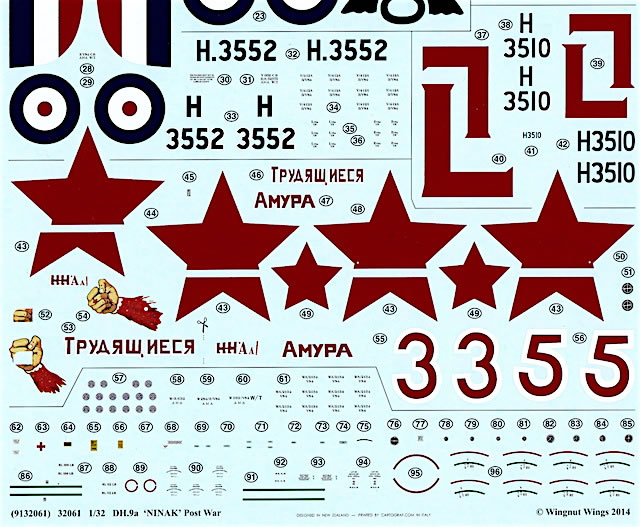
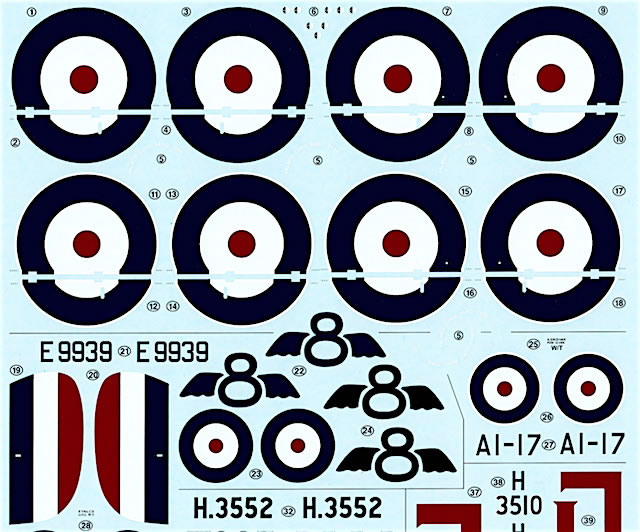
Of course these are only a narrow slice of the marking schemes applied to post-war DH.9as, many of which – freed from wartime camouflage restrictions – were brightly coloured. Some of these machines will be covered in two sets of decals that Rowan Broadbent from Pheon Decals will shortly release. The first Pheon set will feature nine RAF Ninaks, while the second contains markings for one Soviet and one Chinese Nationalist R-1. Preview information about these decals will shortly be available here on HyperScale.
This is a superb kit of an important post-World War I RAF and Soviet aircraft. If you’ve already built a Wingnut Wings kit, you’ll know what to expect; if you haven’t, the Ninak would be a good one to start with. Don’t be put off by the complexity of either the kit or the subject; take your time and the quality of the product will result in a great looking and impressively sized model. Very highly recommended.
Thanks to Wingnut Wings for the review sample.
References
John Bennett, The Imperial Gift – British Aeroplanes which formed the RAAF in 1921 (Banner Books, 1996).
Andy Ieronymides, ‘Ninak’, Model Airplane International, Issue 78, January 2012
Thanks to Wingnut Wings for the sample kit.
Review Text and Images Copyright © 2016 by Brad Fallen
Page Created 24 May, 2016
Last updated
24 May, 2016
Back to HyperScale Main Page

|
